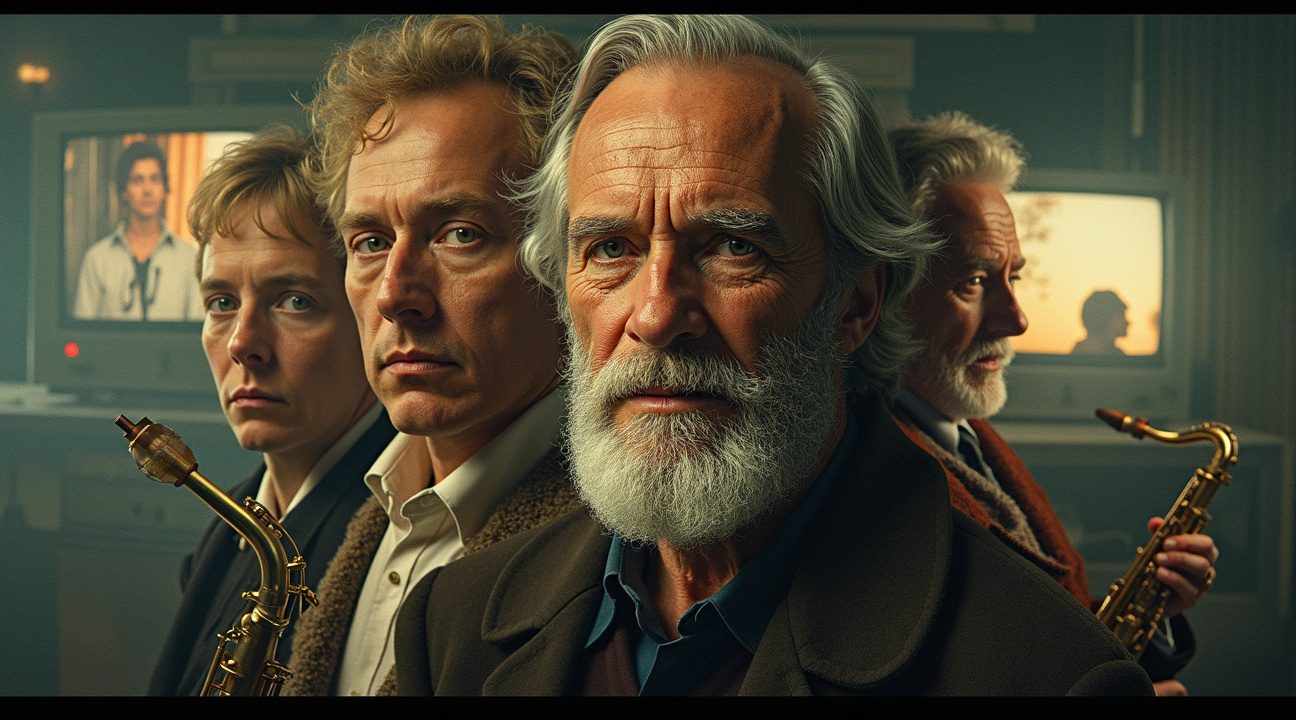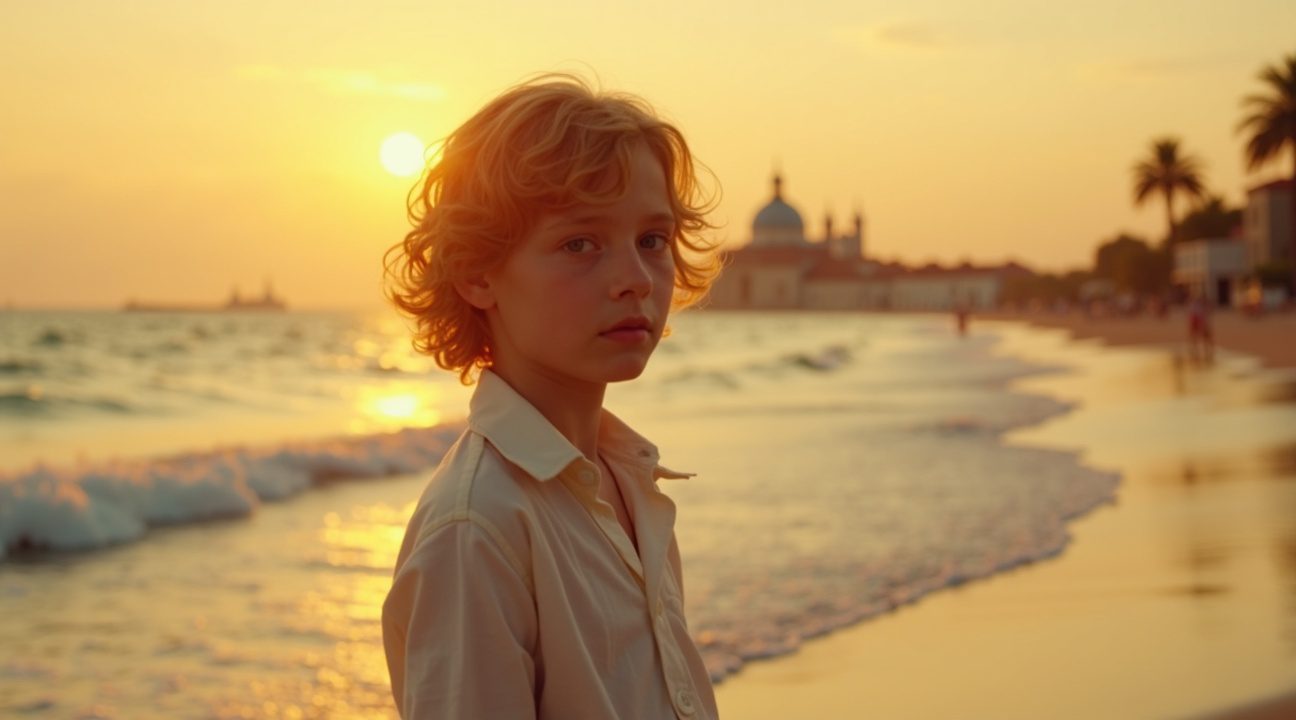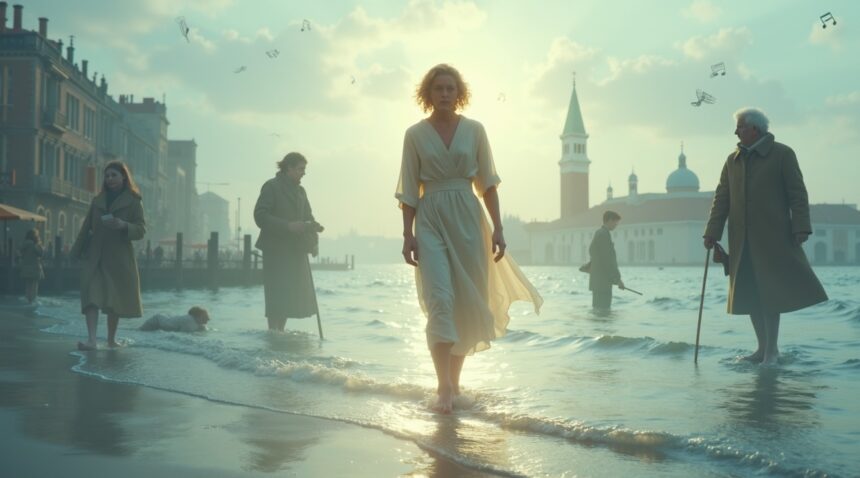Swedish actor Björn Johan Andrésen, best remembered for his ethereal portrayal of Tadzio in Luchino Visconti’s 1971 film “Death in Venice,” passed away on October 25, 2025, in Stockholm at the age of 70.
Legacy of an Iconic Role
Andrésen rose to global fame at just fifteen years old, astonishing audiences with his performance in “Death in Venice”. Selected by Visconti for his delicate beauty and enigmatic presence, Andrésen came to embody the concept of youthful perfection, earning the title “the most beautiful boy in the world.”
Impact and Consequences of Early Fame
While the role brought widespread acclaim, it also introduced a series of personal and professional difficulties for Andrésen. The relentless media spotlight and public fascination that followed his debut came at a cost. He experienced intense objectification and had difficulty escaping the shadow of Tadzio, finding it challenging to be cast in roles that didn’t replicate his youthful image.
Career Beyond Acting
Despite the constraints of early fame, Andrésen nurtured other artistic passions:
- He pursued music, performing with the Swedish dance band Sven Erics.
- He appeared in multiple Swedish television series and films over the decades, building a diverse body of work.
- He made a notable return to international cinema with a role in Ari Aster’s horror hit “Midsommar” (2019).
Behind the Public Image
Andrésen’s personal journey included profound tragedy. His mother died by suicide when he was just ten years old. Later in life, he lost an infant son to sudden infant death syndrome, plunging him into a long period of grief and depression. These experiences shaped his perspective and were explored openly in later years.
A Documentary Reckoning
The 2021 documentary “L’Ange blond de Visconti” (“The Most Beautiful Boy in the World”) offered a moving and deeply personal look at Andrésen’s life. The film highlighted the costs of being a child icon and allowed him to tell his own story, shining a light on the entertainment industry’s often exploitative treatment of young talent.
Key Takeaways
- Andrésen became an international star after “Death in Venice” and was seen as a cultural icon in European cinema.
- He faced significant personal costs, such as typecasting and unwanted media intrusion.
- His creative pursuits included both acting and a musical career with Sven Erics.
- He endured personal tragedies that influenced his outlook and mental health struggles.
- The 2021 documentary allowed him to reclaim his narrative and address the darker side of fame.
Swedish Actor Björn Johan Andrésen Dies at 70 in Stockholm
Swedish actor and musician Björn Johan Andrésen passed away on October 25, 2025, in Stockholm at the age of 70. Born on January 26, 1955, in the Swedish capital, Andrésen stood 1.73 meters tall and carved out a distinctive place in cinema history through one iconic performance.
Andrésen gained worldwide recognition for his portrayal of Tadzio in Luchino Visconti’s 1971 masterpiece Death in Venice. This role catapulted him to international fame and earned him a description that would follow him throughout his career. Critics and audiences frequently referred to him as “the most beautiful boy in the world” due to his striking appearance during his youth.
A Career-Defining Performance
The role of Tadzio in Death in Venice became Andrésen’s most significant contribution to cinema. Visconti’s adaptation of Thomas Mann’s novella required a young performer who could embody beauty and innocence while carrying the weight of the film’s central obsession. Andrésen’s natural charisma and photogenic qualities made him perfect for this demanding role.
His performance in the film resonated with audiences across different cultures and generations. The movie’s success brought both opportunities and challenges, as Andrésen became typecast due to his memorable appearance in this single role. Despite these limitations, his work in Death in Venice remains a testament to his natural acting ability and screen presence.
Beyond his acting career, Andrésen also pursued music, showcasing his artistic versatility. His Swedish heritage influenced much of his later work, though he never quite achieved the same level of international recognition he experienced with his breakthrough film.
The entertainment industry has lost numerous notable figures recently, including other beloved performers who shaped popular culture. Andrésen’s death marks the end of an era for those who remember his captivating screen presence in one of cinema’s most discussed films.
Andrésen’s legacy extends beyond his physical beauty to encompass his contribution to art cinema. His work with Visconti demonstrated how a single performance could define an actor’s career and influence discussions about beauty, youth, and artistic expression for decades to come.
The Boy Who Became an Icon in Death in Venice
At just fifteen years old, Björn Andrésen found himself thrust into international stardom through a single, career-defining role. Director Luchino Visconti cast him as Tadzio in the 1971 film adaptation of Thomas Mann’s “Death in Venice,” a decision that would forever change the young Swedish actor’s life. The casting process itself was extraordinary—Visconti had searched across Europe for the perfect embodiment of Mann’s beautiful youth, eventually discovering Andrésen in Stockholm.
The film transformed Andrésen into what many called “the most beautiful boy in the world”, a title that brought both acclaim and burden. His portrayal of Tadzio captured the essence of platonic beauty that Mann had envisioned in his novella, creating an image that resonated with audiences globally. The ethereal quality Andrésen brought to the screen made the film a classic of cinema, cementing his place in film history despite his youth.
However, the intense media attention that followed proved challenging for the teenage actor. Andrésen later revealed his discomfort with the celebrity status and objectification he experienced after the film’s release. The sudden fame exposed him to scrutiny that few adults could handle, let alone a fifteen-year-old navigating the transition from childhood to adolescence.
The Weight of Beauty and Fame
The media’s fascination with Andrésen extended beyond his acting abilities to focus heavily on his appearance and personal life. Speculation about his sexuality became a persistent theme in press coverage, something he publicly addressed and rejected throughout his career. This unwanted attention highlighted the darker side of child stardom, particularly when combined with the film’s themes and his character’s symbolic significance.
Much like other young performers who achieved fame early, such as Olivia Newton-John, Andrésen discovered that early success could become both a blessing and a constraint. The “Death in Venice” role, while artistically significant, created an image that proved difficult to escape. His striking appearance in the film became so iconic that it overshadowed his subsequent work and personal identity.
The complexity of Andrésen’s relationship with his breakthrough role reflected broader issues within the entertainment industry regarding child performers. His experience demonstrated how a single role, no matter how artistically successful, could define an entire life in ways the young actor never anticipated when he first stepped in front of Visconti’s cameras.

Personal Struggles Behind the Fame
The striking beauty that made Björn Andrésen famous came at a tremendous personal cost, overshadowing a life marked by profound tragedy and loss. Behind the ethereal image that captivated audiences worldwide lay a series of devastating experiences that shaped his character and haunted him throughout his years.
Early Trauma and Family Loss
Andrésen’s childhood was shattered when his mother, Barbro Elisabeth Andrésen, took her own life when he was just ten years old. This traumatic event left an indelible mark on the young boy, who never knew his father’s identity. His maternal grandparents stepped in to raise him, providing stability during his formative years as he attended Adolf Fredrik’s Music School in Stockholm and later spent time at a Danish boarding school.
These early experiences with abandonment and loss would prove to be recurring themes throughout his life. The absence of parental figures during such a critical developmental period contributed to the vulnerability that would later be exploited by those who sought to capitalize on his extraordinary appearance.
Marriage, Parenthood, and Unimaginable Grief
In 1983, Andrésen found love and married poet Susanna Román, beginning what seemed like a promising new chapter. Their union brought two children into the world: daughter Robine in 1984 and son Elvin in 1986. However, joy turned to devastation when baby Elvin died in infancy from sudden infant death syndrome.
The loss of his son plunged Andrésen into profound depression that would persist for years. This tragedy compounded the emotional wounds from his childhood, creating a cycle of grief that influenced his relationship with fame and public attention. Many who knew him during this period described a man struggling to reconcile his public image with private anguish.
The death of a child represents one of life’s most devastating experiences, and for someone already carrying the weight of early trauma, this loss proved particularly crushing. Andrésen’s depression following Elvin’s death wasn’t merely sadness—it was a clinical condition that affected his ability to work, maintain relationships, and engage with the world around him.
Despite these overwhelming challenges, Andrésen found moments of light through his daughter Robine and later through his granddaughters, Lo (born 2008) and Nike (born 2014). These family connections provided anchors during his darkest periods, though they couldn’t entirely lift the shadow of his accumulated losses.
His struggles mirror those of many celebrities who face personal tragedy while living under public scrutiny, much like other beloved figures who’ve faced similar challenges. The contrast between his ethereal screen presence and his internal battles created a dissonance that few understood, highlighting how fame often masks profound human suffering.
Andrésen’s story serves as a reminder that beauty and talent don’t shield anyone from life’s harshest realities. His ability to continue working sporadically throughout his life, despite battling severe depression and processing multiple traumatic losses, demonstrated remarkable resilience. However, the toll of these experiences remained visible to those who knew him personally, creating a complex legacy that extends far beyond his iconic film roles.
The actor’s granddaughters represent the continuation of his lineage and perhaps the redemption he sought through family connections. Their presence in his later years offered glimpses of the peace that had eluded him for so long, though they couldn’t erase the pain that defined much of his adult life.
Career Beyond the Iconic Role
Björn Andrésen’s artistic journey extended far beyond his breakthrough performance in Luchino Visconti’s acclaimed film. His acting career began in earnest with A Swedish Love Story in 1970, establishing him as a promising talent in Swedish cinema before his international recognition in Death in Venice the following year.
The decades that followed showcased Andrésen’s versatility across different mediums and genres. Television became a significant platform for his work, with appearances in several notable Swedish series. Gentlemen & Gangsters demonstrated his ability to handle dramatic material, while Lasermannen and Spring Tide allowed him to explore different character types within the crime and thriller genres. His role in the supernatural series Jordskott further expanded his range within Swedish television’s growing reputation for quality programming.
Perhaps most remarkably, Andrésen experienced a career resurgence later in life when director Ari Aster cast him as Dan in the folk horror sensation Midsommar in 2019. This contemporary role introduced him to a new generation of film enthusiasts and demonstrated his enduring screen presence decades after his initial fame.
Musical Pursuits and Performance
Acting wasn’t Andrésen’s only artistic outlet. He pursued music professionally, performing with the dance band Sven Erics. This musical career ran parallel to his film and television work, showcasing his multifaceted talents beyond the screen. The band provided him with a creative outlet that complemented his acting endeavors and offered audiences a different perspective on his artistic abilities.
His career trajectory illustrated the unique challenges faced by actors who achieve early international recognition. The significant temporal gaps between his high-profile projects reflected both the selective nature of his choices and the realities of maintaining a sustainable acting career across multiple decades. Rather than pursuing constant visibility, Andrésen appeared to choose projects that resonated with his artistic sensibilities.
The span of his work, from his early Swedish films through his late-career appearances, revealed an actor who remained committed to his craft regardless of industry trends. His filmography represents a bridge between different eras of cinema, connecting the auteur-driven films of the 1970s with contemporary horror cinema’s sophisticated storytelling approaches.
Andrésen’s legacy encompasses more than any single performance, reflecting a dedication to artistic expression that manifested across film, television, and music throughout his lifetime.

Documentary and Media Legacy
Björn Andrésen’s complicated relationship with fame reached its most honest portrayal in 2021 through the documentary ‘L’Ange blond de Visconti’ (The Blond Angel of Visconti). This intimate film examined his life beyond the iconic role that defined his career and explored how one performance could shape an entire existence. The documentary provided viewers with an unfiltered look at the man behind the legendary beauty that captivated audiences in Luchino Visconti’s ‘Death in Venice’.
The film revealed the profound personal struggles that Andrésen faced after becoming an overnight sensation. His transformation from a Swedish teenager into an international cultural icon happened almost instantaneously, leaving him unprepared for the intense scrutiny that followed. The documentary captured his reflections on decades of being reduced to a symbol of ethereal beauty, showing how this reduction affected his sense of identity and personal relationships.
The Weight of Iconic Status
Throughout the documentary, Andrésen spoke candidly about the relentless media attention that followed him for decades after his breakthrough role. He described feeling trapped by an image that others had created for him, unable to escape the expectations and projections that came with his status as a beauty icon. The film highlighted several key aspects of his media experience:
- The overwhelming nature of sudden international fame at such a young age
- His struggle to establish an identity separate from his most famous character
- The psychological impact of being constantly objectified and idealized
- The difficulty of pursuing meaningful artistic work while being typecast
- His complex feelings about the role that made him famous yet limited his opportunities
The documentary served as both a personal confession and a broader commentary on the entertainment industry’s treatment of young performers. Andrésen’s story became a cautionary tale about the lasting consequences of child stardom and the responsibility that filmmakers and media outlets bear when working with minors. His experiences echoed those of other young stars who found fame to be both a blessing and a burden, much like other entertainment figures who struggled with the complexities of public life.
The film also examined how Andrésen’s image became disconnected from his actual personality and aspirations. He revealed that many people expected him to embody the same mysterious, otherworldly qualities that made his character in ‘Death in Venice’ so compelling. This expectation created a disconnect between his public persona and his private reality, making genuine human connections increasingly difficult as he aged.
‘L’Ange blond de Visconti’ ultimately positioned Andrésen’s story within the larger conversation about exploitation in the film industry and the protection of young performers. His experiences illustrated how the pursuit of artistic excellence could sometimes come at the expense of an individual’s well-being and development. The documentary didn’t shy away from exploring the darker aspects of his journey, including periods of depression and his struggles with alcohol.
The film’s release brought renewed attention to Andrésen’s life and career, but this time on his own terms. Instead of being the subject of speculation and projection, he became an active participant in telling his own story. The documentary allowed him to reclaim some control over his narrative and provide context for the choices he made throughout his life.
His legacy through this documentary extends beyond his individual experience to serve as an important document about the evolution of celebrity culture and the film industry’s relationship with its youngest stars. The honesty and vulnerability he displayed in ‘L’Ange blond de Visconti’ created a lasting testament to the human cost of fame and the importance of protecting young people in the entertainment industry.
https://www.youtube.com/watch?v=V6rS7lEG-YQ
Cultural Impact and Enduring Influence
Björn Andrésen carved an indelible mark on European cinema through a single transformative role that would define conversations about beauty, youth, and artistic representation for generations. His portrayal of Tadzio in Luchino Visconti’s “Death in Venice” transcended typical acting performances, becoming a cultural touchstone that continues to influence filmmakers, scholars, and audiences worldwide.
A Defining Performance in Cinema History
Andrésen’s embodiment of adolescent beauty and innocence in the 1971 masterpiece established him as more than just an actor—he became a cultural icon whose image sparked decades of academic discourse. Film scholars consistently reference his performance when examining the intersection of cinema and desire, particularly within the context of European art house films. The ethereal quality he brought to Tadzio created a visual poetry that elevated Visconti’s adaptation of Thomas Mann’s novella into something approaching the sublime.
Cinema studies programs across universities continue to analyze his work, not merely for its artistic merit but for its broader implications about representation and the male gaze in film. His performance has become essential viewing for students exploring the evolution of European cinema and its treatment of complex themes surrounding identity and attraction.
Lasting Influence on Queer Theory and Cultural Discourse
The cultural resonance of Andrésen’s image extends far beyond traditional film criticism into the academic field of queer theory. Scholars have extensively examined how his portrayal challenged conventional notions of masculinity and beauty, creating space for more nuanced discussions about gender presentation and sexual identity in cinema. His work provided a foundation for analyzing how European filmmakers approached LGBTQ+ themes during an era when such representations remained largely taboo in mainstream entertainment.
The enduring fascination with his performance reflects broader cultural conversations about fame, beauty, and the responsibility of artists when depicting youth on screen. Critics and theorists continue to explore how his image was both celebrated and commodified, examining the ethical implications of his early stardom and its impact on his subsequent career choices.
Throughout his career spanning more than five decades, Andrésen successfully navigated between his identity as both actor and musician, demonstrating artistic versatility that extended beyond his most famous role. His musical endeavors provided him with creative outlets that allowed for more personal expression, away from the intense scrutiny that followed his breakthrough performance.
The conversations his life and work provoked about the nature of beauty standards, the pressure of early fame, and the complexity of artistic identity remain relevant in contemporary discussions about celebrity culture and media representation. His influence can be traced through subsequent generations of European filmmakers who approach similar themes with greater sensitivity and awareness, partly due to the groundwork his career established.
Modern cinema continues to reference and draw inspiration from the visual language Visconti and Andrésen created together. Directors working with themes of youth, beauty, and desire often acknowledge the benchmark his performance set for authentic, emotionally resonant portrayals of complex characters. Much like how other entertainment legends left lasting impacts on their respective industries, Andrésen’s contribution to film art extends well beyond his individual performances.
The academic world has embraced his work as a case study for examining how single performances can reshape cultural conversations and influence artistic movements. Film festivals and retrospectives regularly feature his work, ensuring new generations of viewers can experience the power of his screen presence and understand its significance within the broader context of cinema history.
His legacy demonstrates how an actor’s cultural impact can transcend traditional measures of commercial success or critical acclaim, instead creating lasting influence through the depth and authenticity of artistic expression. The continued scholarly interest in his work proves that certain performances become cultural artifacts that speak to universal human experiences while remaining firmly rooted in their specific historical and artistic contexts.

Sources:
IMDb: Björn Andrésen
Wikipedia: Björn Andrésen
Wikipedia (French): Björn Andrésen
Elfagr: “Björn Andrésen, l’acteur suédois, célèbre pour ‘Mort à Venise’, vit paisiblement à 70 ans”


